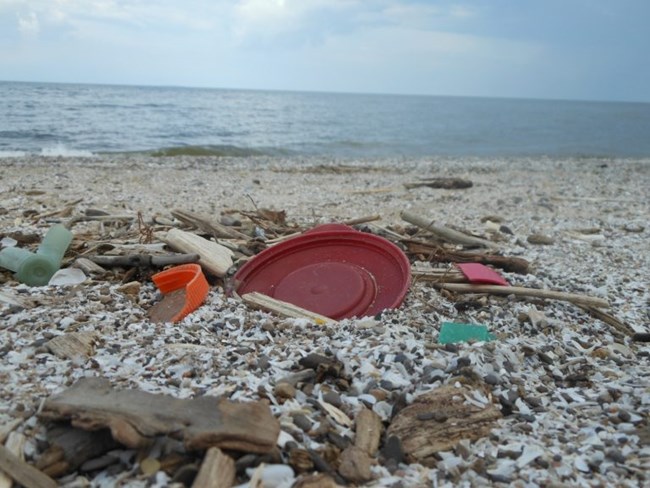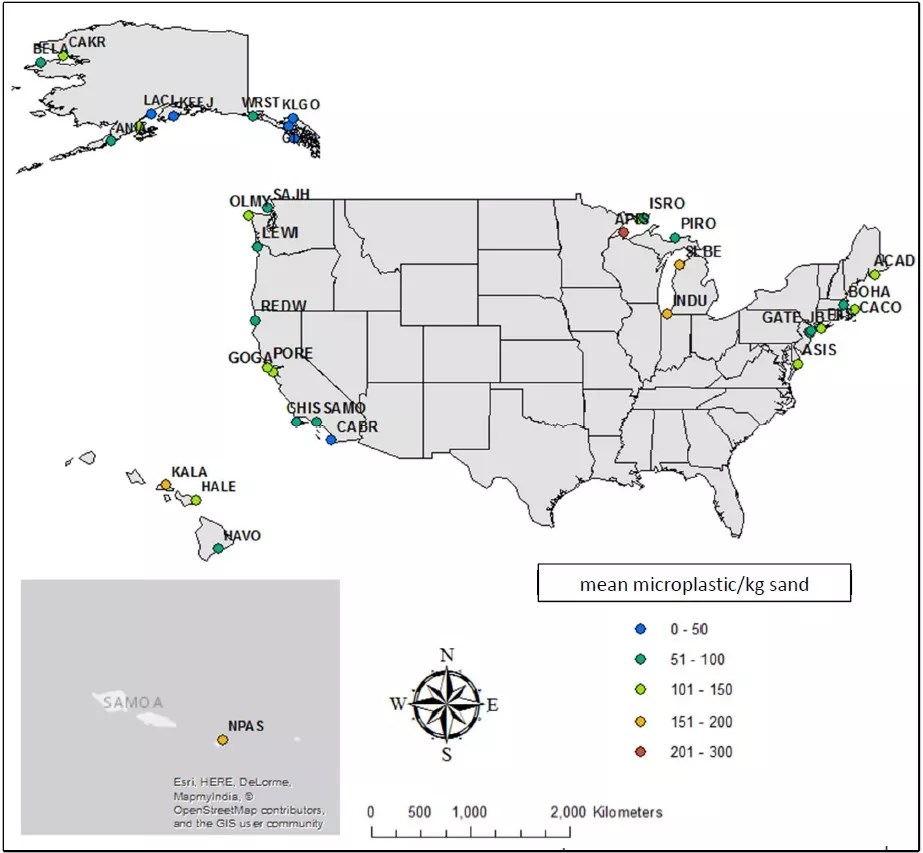Last updated: August 8, 2024
Article
Microplastics on Great Lakes Beaches
Every beachgoer has probably noticed plastic trash littering their favorite beaches, however remote. A new study of microplastic distribution on national park beaches indicates that whichever one you visit, there is probably also some amount of plastic that is harder to see, mixed in with the sand between your toes. The study found that Great Lakes beaches have some of the highest concentrations of microplastics of the areas sampled. In an analysis of 20 years of data from the volunteer-ran Adopt-a-Beach program, Alliance For the Great Lakes found that 86% of litter collected on Great Lakes beaches was partially or entirley made of plastic. The presence of microplastics in the marine environment poses risks to wildlife and human health.

NOAA
What Are Microplastics?
Microplastics are plastic particles less than 5 millimeters in diameter that come from a wide range of sources including soaps, synthetic clothing and textiles, Styrofoam™, and degraded pieces of plastic litter such as bottles and bags (see sidebar). Microplastics often enter lakes and streams as larger pieces of plastic trash that break down over time. Smaller pieces can also be carried on and deposited by the wind. Effluent from wastewater treatment plants often carries the microbead exfoliants that go down the bathroom drain and the fleece and nylon lint from our laundry machines that can pass through the treatment filters and into lakes and streams.

NOAA
What's the Problem?
A primary concern about microplastics is their potential to harm aquatic organisms. Microplastics continue to break down into smaller and smaller particles, which can be ingested by anything from tiny plankton and mussels to larger fish and birds. But how microplastics affect those who eat them is not fully understood. Some organisms can eliminate some shapes and sizes of microplastics from their bodies, but others, especially fibers––the most common microplastic type observed during this study––can tangle into tight balls and become lodged in an organism’s gut.
We also know that plastics can contain a variety of toxic or endocrine-disrupting chemicals such as flame retardants, antimicrobial compounds, and bisphenol-A––an industrial chemical used primarily to make polycarbonate plastic and epoxy resins. Plastics also can act as sponges for toxic contaminants in the surrounding water, absorbing polychlorinated biphenyls (PCBs), polycyclic aromatic hydrocarbons (PAHs), organochlorine pesticides, and metals. Many of these are toxic to animals and humans, and there is some evidence that these contaminants may be transferred from the microplastics to the tissues of fish and other organisms when eaten. Though some laboratory studies show no ingestion-related effects, others have reported that organisms ingesting microplastics might experience inhibited reproduction, growth, and ability to avoid predators. Browne et al. (2013) found that plastic and contaminants harm the physiological functions of marine sedimentary organisms. They saw the desorption of contaminants directly from the plastic in the gut, as well as from sand. This could lead to not only organismal level effects but population level effects and changes in ecosystem dynamics. Microplastics have also been shown to transport pathogens from wastewater treatment facilities to downstream locations, presenting a potential human health issue.

pieces per kg of sand (by color).
NOAA / NPS / Clemson University
They’re Everywhere!
The Great Lakes had relatively high levels of microplastics in surface waters as well as its tributaries, but surface water microplastic abundance was variable. Lake Superior had as much as 12,645 pieces per km2. The lake has long turnover rates, which could allow microplastics to remain for long periods. The NPS sites in Lake Superior had some of the highest microplastic loads in the entire study (such as Apostle Islands National Lakeshore). Most microplastics entered the Great Lakes via its tributaries. This would explain the high counts at Apostle Islands National Lakeshore, which is located near the mouth of the St. Louis River. This river runs through Duluth, MN, and is the largest tributary of the lake with a 3,584-square-mile watershed. Strong currents that move from Duluth eastward toward the Apostle Islands, along with complicated wave action around the islands, would increase the probability of elevated microplastic loads. Pictured Rocks, a park at the other end of Lake Superior, had one of the lowest levels of microplastics in the Great Lakes. This park had very little developed land nearby and all the watersheds for this park flow south into Lake Michigan. Thus, most of the microplastic load here was probably transported from other areas of Lake Superior, but this transport was likely limited by being on the lee side of the Keweenaw Peninsula that sticks out into the lake between Apostle Islands National Lakeshore and Pictured Rocks National Lakeshore.It is challenging to determine the source of anthropogenic microplastics. Studies state that as much as 80% of microplastics come from urban, land-based sources. For the sites in this study, there was no relationship between microplastic load and the amount of urbanized area. This seems generally surprising based on known sources of microplastics. Even though many of the NPS sites are remote, some still have midrange counts of microplastics relative to other sites in this study (like Pictured Rocks National Lakeshore in Michigan). Other studies have failed to observe a relationship with urban development and microplastic loads. For example, in a study of tributaries in the Great Lakes region there was no relationship between microplastic loads and proximity of the sites to urban area (Baldwin et al. 2016).
The Influence of Currents and Run-Off
There are strong currents and long residence times for the waters of Lake Michigan as well. At the south end of the lake there is a strong counterclockwise coastal current that travels from Wisconsin to Muskegon, MI creating a rotating gyre in the southern basin of Lake Michigan that traps chlorophyll a. This water movement could also trap microplastics in the southern basin of the lake, increasing the opportunities for the microplastics to be blown to the shores of parks on the east side of Lake Michigan such as Indiana Dunes.The Great Lakes region was likely influenced by run-off as well. Neither our study nor Baldwin et al (2016) found relationships between the counts of microplastics and urban area or WWTP contribution. Baldwin et al. suggested that overland flow was a likely culprit of the levels of microplastic in tributaries. Sewage sludge that traps most of the microplastics from household waste is often applied to agricultural fields. Thus, during precipitation events, microplastics in applied sludge can run-off to downstream environments. The agriculturally-dominated landscape around the lakes increases the opportunity for this to be a microplastic source. Since much of the area is undeveloped, septic tank overflow during times of high flow events could also contribute.
What Can We Do?
This sampling effort provided the opportunity to examine the distribution of microplastics and microfibers in relation to a variety of factors such as local geography, ocean currents, and levels of urbanization. The examined distribution of microplastics and microfibers across a wide geographic area helped us understand how this debris migrates, its most likely sources, and what geographic areas are most prone to its impacts. From this, we can begin to identify how best to reduce input and impacts to humans and wildlife.
Efforts to solve the complex problem are underway regionally, nationally, and internationally. The U.S. Marine Debris Act (2006) and Save our Seas Acts (2018 and 2020) prioritize the prevention, research, assessment, and removal of marine debris, with specific actions to understand and address microplastics. The U.S. also passed the Microbead-Free Waters Act of 2015, which banned rinse-off cosmetics that contain intentionally added plastic microbeads.
A Great Lakes Marine Debris Action Plan was developed in 2020 through a voluntary, collaborative effort of 39 organizations from the United States and Canada to address marine debris through coordinated actions. This five-year Action Plan lays out 47 actions focused on research and monitoring, policy and management, prevention, and removal of marine debris.
Solutions also begin with our personal choices. Single use and disposable items are deeply ingrained in our everyday lives, and they can all become marine debris and microplastics. By working as a community, we can all help protect the Great Lakes. We can pick up the trash we find on our local streets, in our rivers and streams, and on our beaches. We can reduce the amount of plastics we purchase and carry reusable alternatives wherever we go. Together, we can be part of the solution and prevent microplastics in the Great Lakes.
This project
was funded by the NOAA Marine Debris Program and led by the National Park Service and Clemson University. The full report can be found here.
Tags
- apostle islands national lakeshore
- indiana dunes national park
- isle royale national park
- pictured rocks national lakeshore
- sleeping bear dunes national lakeshore
- microplastics
- great lakes
- plastic
- indiana dunes
- lake michigan
- lake superior
- lake erie
- lake ontario
- lake huron
- noaa
- noaa marine debris program
- beaches
- pollution
- park science
- great lakes network
